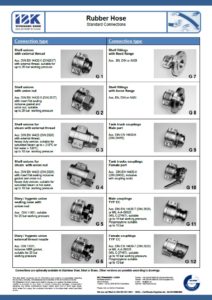[tabs style=”button” position=”top-left”] [tab_title]Description[/tab_title] [tab_content]
IBK – Cooling Water Hose Type Piave
Description
- Delivery hose for conveying cooling water
- Normally used in foundries and steel mills
- The special outer glass fiber protection withstands splashes of incandescent material and radiation heat up to + 400°C
Tube
- Synthetic rubber, black, smooth
Reinforcement
- Plies of high strength synthetic textile
Cover
- Synthetic rubber, smooth, covered with a light colored vulcanized glass fiber and its resistance to radiation heat up to + 400°C
Temperature resistance media
- From – 30°C up to + 70°C
- Peaks up to + 90°C (depending on media)
Safety Factor
- > 3-times working
[tabs style=”button” position=”top-left”] [tab_title]Technical Data[/tab_title] [tab_content]
Size Tolerances
Internal Diameter: ISO 1307 / Wall Thickness: DIN 7715 T4 S2 / Length: ISO 1307
| Internal Diameter (mm) | Wall Thickness (mm) | Bending Radius | Working Pressure 20°C (bar) | Vacuum | Theoretical Weight (kg / m) | Length max. (m) |
|---|---|---|---|---|---|---|
| 19 | 6.0 | 114* | 16** | - | 0.55 | 40 |
| 25 | 6.0 | 150* | 16** | - | 0.75 | 40 |
| 32 | 6.0 | 192* | 16** | - | 1.10 | 40 |
| 38 | 7.0 | 228* | 16** | - | 1.40 | 40 |
| 40 | 7.0 | 240* | 16** | - | 1.50 | 40 |
| 50 | 8.0 | 300* | 16** | - | 1.70 | 40 |
| 65 | 8.0 | 390* | 16** | - | 2.50 | 40 |
| 75 | 8.0 | 450* | 16** | - | 2.80 | 40 |
| 80 | 8.0 | 480* | 16** | - | 3.05 | 40 |
| 100 | 8.0 | 600* | 16** | - | 3.80 | 40 |
| 125 | 9.0 | 800* | 16** | - | 5.00 | 40 |
| 150 | 15.0 | 900* | 16** | - | 8.20 | 20 |
| 203 | 15.0 | 1200** | 16** | 11.90 | 12 |
* The bending radius can be reached at a working pressure of > 1 bar
** Hose is also available in other pressure ranges
→ Other sizes and different versions are available on request. Pictures might be different to the original
[tabs style=”button” position=”top-left”] [tab_title]Standard Connections[/tab_title] [tab_content]
Our Rubber hoses are manufactured according to the customers’ request.
Especially the connections play an important role.
Further information for the different types of connections you can get here

